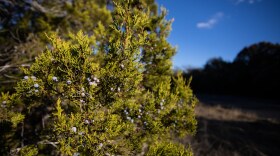Cedar fever is back in Austin with a vengeance.
The allergy-inducing pollen hit the region early this year, and with it came sinus issues, fatigue and itchy, watery eyes.
Cedar fever comes from the pollen released by Ashe juniper – also known as mountain cedar – trees. And in Austin, particularly west of I-35, these trees are everywhere. Ashe junipers make up about a third of the trees in the city, with roughly 12 trees for every Austin resident. And when cold snaps arrive, millions of Ashe junipers release high concentrations of pollen to the masses.
Kristin Foley, a family nurse practitioner with Greater Austin Allergy, said about a quarter of her patients test positive for cedar allergy. And if you’re new to Austin and aren't experiencing any symptoms, Foley says to wait a few years: The allergy can develop over time.
But you don't even need to be allergic or live near a dense cluster of Ashe junipers to feel the effects of their pollen.
Large quantities of pollen can be carried by the wind, triggering your body's defense response as it perceives the particles as a threat, according to the Texas A&M Forest Service.
“Cold fronts are marked by very dry and windy conditions with rapid pressure changes which trigger pollen cones to open and release pollen grains,” said Robert Edmonson, a Texas A&M Forest Service biologist. “In certain conditions, you can even see the pollen blowing off trees.”
You don't need to be outside for a long period of time to experience symptoms, either.
“You could just be one that runs into H-E-B to go get groceries, runs out," Foley said. "And that may be enough for your body to say, 'Ugh I don’t like this’ and start to feel bad.'"
Foley said it's called cedar fever because our bodies' reaction to the pollen really feels like an illness.
“Patients will have extreme fatigue, severe nasal congestion, itchy watery eyes, runny nose and sneezing as well,” she said.
It can also come with a low-grade fever, but anything over 100 degrees Fahrenheit is probably something else, Foley said.
If you are particularly sensitive to cedar, buckle in. Ashe juniper pollen typically peaks around mid-January and doesn't taper off until around March.
But it's not all doom and gloom.
Cedar fever can be treated with over-the-counter antihistamines. To limit exposure to pollen, the Texas A&M Forest Service recommends keeping your windows and doors closed and upgrading or replacing the HVAC filters in your home and car.
Foley recommends changing your cedar-laden clothes and taking a shower right when you get home to get rid of lingering pollen on your body.
“When all of that stuff is not enough," she said, "if you don’t want to have to take medicines all day every day, your next bit of armor would be coming in to see an allergist."





